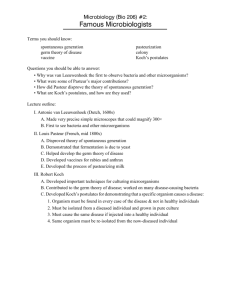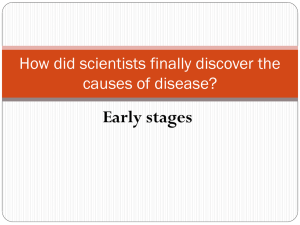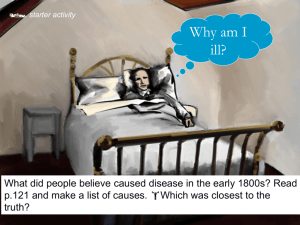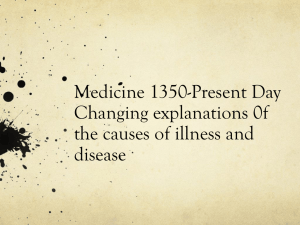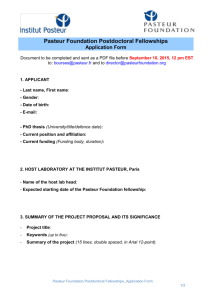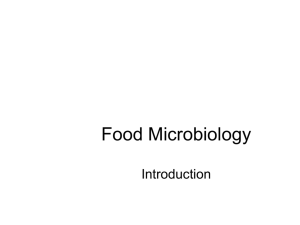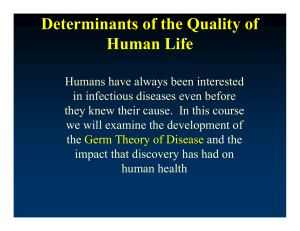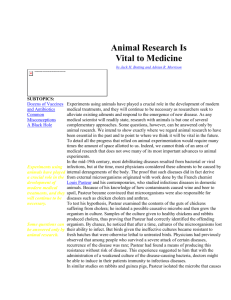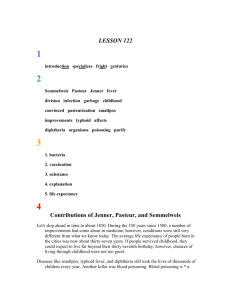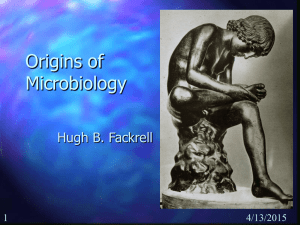Immunology/Germ Theory
advertisement
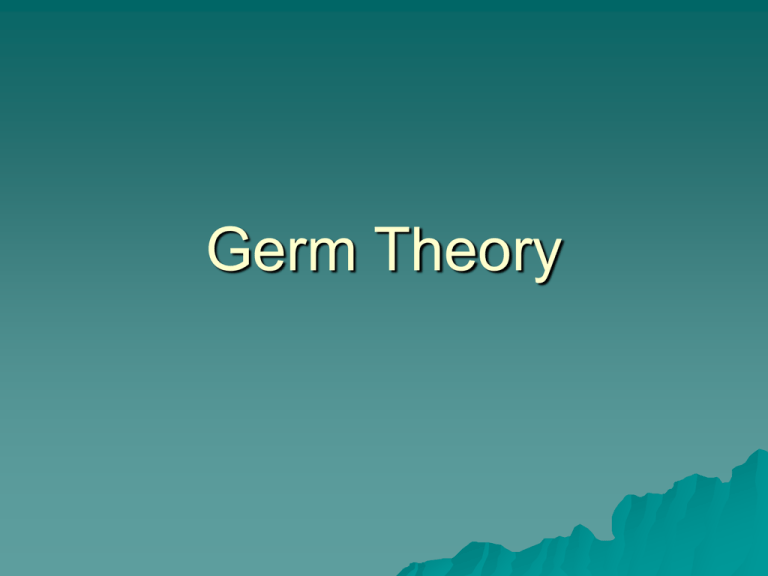
Germ Theory Acceptance of germ theory highly significant for medicine Reformation of both theory and practice – Immunology – Antiseptic/aseptic surgery – Public health Made medicine more effective Refuting Spontaneous Generation Bacteriology began in 17th century No one knew if bacteria had a biological function Commonly believed the putrefaction (spoilage) generated bacteria Based on older belief in spontaneous generation – Mice – Maggots Francisco Redi (c.1621 – c.1697) – Proved maggots were not sponanteously generated People still assumed bacteria could spontaneously generate John Tuberville Needham (17311781) – Apparently proved this hypothesis – Bacteria appeared in sterilized broth Lazzaro Spallanzani (17291799) Sealed flasks after sterilizing broth No bacteria Claimed to have disproved spontaneous generation Critics claimed all it proved was that spontaneous generation could not occur without air Debate century not resolved until the 19th Louis Pasteur (1822-1895) Disagreed with theory of spontaneous generation Strongly influenced by his religious beliefs Those who opposed Darwin’s theory also opposed spontaneous generation Appeared morality Pasteur’s to threaten human work in the wine industry caused him to believe that bacteria caused fermentation (not vice versa) Pasteur was opposed by Felix Pouchet (1800-1872) Demonstrated that even carefully sterilized infusions would spoil if exposed to oxygen Declined to enter into a public contest with Pasteur In fact, Pouchet might have won No one knew about heat resistant (spore forming) bacteria In later years, Pasteur was forced to admit that these organisms could threaten sterilizing techniques Today, scientists believe that life did arise spontaneously on early Earth So, By was Pasteur correct or not? 1890s, spontaneous generation rejected as an explanation for putrefaction Accepting Contagion Theory Prior to 19th century, contagion theory not accepted Some observed facts seemed to fly in face of contagion Diseases could break out in widely separated areas of the country People who attended the sick didn’t always succumb to the disease Miasma (bad air) a common experience in crowded urban environments where disease broke out Also evidence that supported contagion theory Sometimes Outbreaks routes attendants did get sick often followed trade Debate divided 19th century medical community Had huge implications for disease control – Quarantine – Public health policy John Snow (18131858) Transmission of cholera Traced 1854 outbreak to a water pump on Broad St. Cholera transmissible in water William Budd announced similar conclusion days later Did not know what spread the illness Budd speculated that it was a fungus Next step in acceptance of germ theory was to establish that bacteria passed from one victim to another Casimir-Joseph Davaine (1812-1882) Studied anthrax in cattle Identified large microbes in blood of infected animals This discovery received little attention Robert Koch (1843-1910) Intrigued by Davaine’s findings Discovered that anthrax bacteria formed spores Able to relate this finding to the epidemiological facts surrounding outbreaks Published findings in 1876; one year before Pasteur 1880: Published on bacteria found in surgical infections 1882: Discovered M. tuberculosis 1883: Dicovered V. cholerae Success based on exceptional technical expertise Development of solid culture media .Germ theory commonly accepted by medical community 1880-1900 golden age of bacteriology New bacterial diseases identified at rate of 1/yr – Gonococcus – Syphilis – Child bed fever Fuelled hopes that diseases such as cancer also caused by germs Impact of Germ Theory Dramatic consequences for public health Emphasis on breaking chain of infection – Discovery of healthy carriers – Typhoid fever – Story of typhoid Mary Germ phobia & changes in hygienic practices Decline of the theory of predisposition Immunology Based on the fact that living entities have immune systems Can artificially produce immunity – Artificial passive immunity – Artificial active immunity Smallpox & artificial active immunity already discussed Immunology After Vaccination Several other vaccines were produced in the late 19th century Produced by manipulating organisms so that they lose virulence, but retain capacity to produce antibodies – Attenuated vaccines – Killed vaccines Pasteur played significant role Accidental attenuation of chicken cholera organism Discovered it rendered chickens immune to the virulent organism Used this model to develop anthrax vaccine Also developed rabies vaccine Pasteur criticized by some of his contemporaries and present day historians – Used unproven vaccine on Joseph Meister – Appropriated techniques developed by other researchers – Was not completely honest about how he produced anthrax & rabies vaccine Stakes were very high for these researchers General public desperate for solutions Koch and development of tuberculin another example Impact of vaccines – Mortality due to contagious diseases fell dramatically – Mortality shifted to chronic diseases Other impacts of germ theory – Search for specific remedies – Abandonment of general therapies – Reduced mortality after introduction of aseptic techniques
